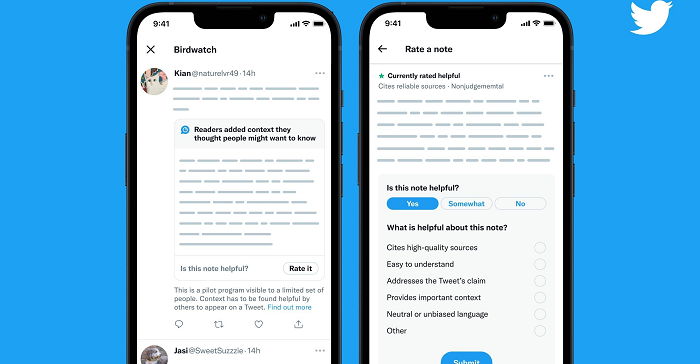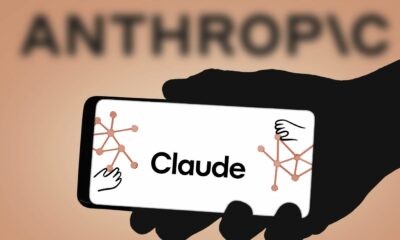SOCIAL
Twitter Announces an Expansion of its ‘Birdwatch’ Crowd-Sourced Fact-Checking Program

This seems… concerning.
Today, just weeks out from the US midterms, Twitter has announced that it will expand its experimental Birdwatch crowd-sourced fact-checking program, as a means to combat misinformation throughout the app.
As you can see in these examples, Birdwatch, which Twitter first launched early last year, enables participants to highlight information in Tweets that they believe is misleading, and add notes to provide additional context.
Anyone can apply to become a Birdwatch contributor (where it’s available), so long as you have a verified phone number, no recent Twitter rule violations, and a minimum of six months using the app. The process then cross-matches the contributions from Birdwatch participants to highlight the notes rated as most helpful, based on a range of qualifiers, with all Birdwatch notes available for anyone to see.
Which is an interesting approach to content moderation, putting more onus on the user community to dictate what is and is not acceptable, as opposed to internal moderation teams making that call.
And it works. Twitter says that, according to its research, people who see a Birdwatch note are 20-40% less likely to agree with the substance of a potentially misleading Tweet than someone who sees the Tweet alone. Twitter also says that people who see Birdwatch notes are 15-35% less likely to Like or Retweet a Tweet than someone who sees the Tweet alone.
So, it’s having an impact, and it could be a good way to dispel misinformation, even if it does seem a little risky putting such rulings into the hands of users.
Either way, Twitter’s confident enough to move ahead with the experiment:
“We’ll start by adding larger groups of eligible applicants to the pilot on a more frequent basis. The process will be adjusted as needed as we closely monitor whether this change has any impact on either the quality or the frequency of contributions.”
So more applicants will now be accepted into the Birdwatch program, which will expand the pool of citizen fact-checkers.
“The visibility of notes on public Tweets will also be increasing. In the coming weeks, more people using Twitter in the US will start to see notes on Tweets that Birdwatch contributors have collectively identified as Helpful. Importantly, this doesn’t mean you’ll start seeing notes on every Tweet, simply that a larger number of you will start seeing notes that have been rated Helpful.”
Twitter also says that it’s rolling out an updated Birdwatch onboarding process, which will better incentivize contributors to write and rate notes in a thoughtful way.
“New Birdwatch contributors who have met the eligibility criteria will begin with an initial Rating Impact score of zero, which they can increase by consistently rating other contributors’ notes and reliably identifying those that are Helpful and Not Helpful. Once a contributor’s score has risen to five, they can start writing notes. Contributors can further increase their Writing and Rating Impact scores by both writing Helpful notes and continuing to rate notes written by others.”

More fact-checkers, more notes highlighted, and more incentive for contributors to contribute to the quality of the ratings. It’s a significant expansion of the program, which, again, has shown promising results thus far.
But then again, there is also this:
“Twitter’s crowdsourced fact-checking program, Birdwatch, accepted a QAnon supporter account into its ranks, according to a leaked internal audit. To make matters even worse, Twitter had been warned by experts ahead of time that this exact scenario might be possible.”
As reported by Input Magazine, there may still be some potential flaws in Twitter’s Birdwatch system, with this incident highlighted by former Twitter security advisor Peiter Zatko in his recent revelations about flaws in Twitter’s security processes.
The individual in question was removed from the program before contributing notes, so any potential conflict was avoided in this instance. But Zatko has warned that there are significant flaws in this approach, which could be exploited by those seeking to infiltrate the system.
An expansion of the Birdwatch program – essentially upping the stakes for those that may be looking for ways to influence the conversation – will make it an even bigger target, and as the system becomes more prominent, that will make bad actors pay even more attention to the option as a vector for influence.
That’s not to say that Twitter can’t, or won’t, counter any attempts at misuse. But it is an important element to watch – and ahead of the US midterms, when political attention will be higher than ever, it could be a risky bet to expand the program at this stage.
It does seem like a well-conceived system. But even seemingly well-thought-out programs have been impacted by bad actors in the past.
SOCIAL
12 Proven Methods to Make Money Blogging in 2024

 This is a contributed article.
This is a contributed article.
The world of blogging continues to thrive in 2024, offering a compelling avenue for creative minds to share their knowledge, build an audience, and even turn their passion into profit. Whether you’re a seasoned blogger or just starting, there are numerous effective strategies to monetize your blog and achieve financial success. Here, we delve into 12 proven methods to make money blogging in 2024:
1. Embrace Niche Expertise:
Standing out in the vast blogosphere requires focus. Carving a niche allows you to cater to a specific audience with targeted content. This not only builds a loyal following but also positions you as an authority in your chosen field. Whether it’s gardening techniques, travel hacking tips, or the intricacies of cryptocurrency, delve deep into a subject you’re passionate and knowledgeable about. Targeted audiences are more receptive to monetization efforts, making them ideal for success.
2. Content is King (and Queen):
High-quality content remains the cornerstone of any successful blog. In 2024, readers crave informative, engaging, and well-written content that solves their problems, answers their questions, or entertains them. Invest time in crafting valuable blog posts, articles, or videos that resonate with your target audience.
- Focus on evergreen content: Create content that remains relevant for a long time, attracting consistent traffic and boosting your earning potential.
- Incorporate multimedia: Spice up your content with captivating images, infographics, or even videos to enhance reader engagement and improve SEO.
- Maintain consistency: Develop a regular publishing schedule to build anticipation and keep your audience coming back for more.
3. The Power of SEO:
Search Engine Optimization (SEO) ensures your blog ranks high in search engine results for relevant keywords. This increases organic traffic, the lifeblood of any monetization strategy.
- Keyword research: Use keyword research tools to identify terms your target audience searches for. Strategically incorporate these keywords into your content naturally.
- Technical SEO: Optimize your blog’s loading speed, mobile responsiveness, and overall technical aspects to improve search engine ranking.
- Backlink building: Encourage other websites to link back to your content, boosting your blog’s authority in the eyes of search engines.
4. Monetization Magic: Affiliate Marketing
Affiliate marketing allows you to earn commissions by promoting other companies’ products or services. When a reader clicks on your affiliate link and makes a purchase, you get a commission.
- Choose relevant affiliates: Promote products or services that align with your niche and resonate with your audience.
- Transparency is key: Disclose your affiliate relationships clearly to your readers and build trust.
- Integrate strategically: Don’t just bombard readers with links. Weave affiliate promotions naturally into your content, highlighting the value proposition.
5. Display Advertising: A Classic Approach
Display advertising involves placing banner ads, text ads, or other visual elements on your blog. When a reader clicks on an ad, you earn revenue.
- Choose reputable ad networks: Partner with established ad networks that offer competitive rates and relevant ads for your audience.
- Strategic ad placement: Place ads thoughtfully, avoiding an overwhelming experience for readers.
- Track your performance: Monitor ad clicks and conversions to measure the effectiveness of your ad placements and optimize for better results.
6. Offer Premium Content:
Providing exclusive, in-depth content behind a paywall can generate additional income. This could be premium blog posts, ebooks, online courses, or webinars.
- Deliver exceptional value: Ensure your premium content offers significant value that justifies the price tag.
- Multiple pricing options: Consider offering tiered subscription plans to cater to different audience needs and budgets.
- Promote effectively: Highlight the benefits of your premium content and encourage readers to subscribe.
7. Coaching and Consulting:
Leverage your expertise by offering coaching or consulting services related to your niche. Readers who find your content valuable may be interested in personalized guidance.
- Position yourself as an expert: Showcase your qualifications, experience, and client testimonials to build trust and establish your credibility.
- Offer free consultations: Provide a limited free consultation to potential clients, allowing them to experience your expertise firsthand.
- Develop clear packages: Outline different coaching or consulting packages with varying time commitments and pricing structures.
8. The Power of Community: Online Events and Webinars
Host online events or webinars related to your niche. These events offer valuable content while also providing an opportunity to promote other monetization avenues.
- Interactive and engaging: Structure your online events to be interactive with polls, Q&A sessions, or live chats. Click here to learn more about image marketing with Q&A sessions and live chats.
9. Embrace the Power of Email Marketing:
Building an email list allows you to foster stronger relationships with your audience and promote your content and offerings directly.
- Offer valuable incentives: Encourage readers to subscribe by offering exclusive content, discounts, or early access to new products.
- Segmentation is key: Segment your email list based on reader interests to send targeted campaigns that resonate more effectively.
- Regular communication: Maintain consistent communication with your subscribers through engaging newsletters or updates.
10. Sell Your Own Products:
Take your expertise to the next level by creating and selling your own products. This could be physical merchandise, digital downloads, or even printables related to your niche.
- Identify audience needs: Develop products that address the specific needs and desires of your target audience.
- High-quality offerings: Invest in creating high-quality products that offer exceptional value and user experience.
- Utilize multiple platforms: Sell your products through your blog, online marketplaces, or even social media platforms.
11. Sponsorships and Brand Collaborations:
Partner with brands or businesses relevant to your niche for sponsored content or collaborations. This can be a lucrative way to leverage your audience and generate income.
- Maintain editorial control: While working with sponsors, ensure you retain editorial control to maintain your blog’s authenticity and audience trust.
- Disclosures are essential: Clearly disclose sponsored content to readers, upholding transparency and ethical practices.
- Align with your niche: Partner with brands that complement your content and resonate with your audience.
12. Freelancing and Paid Writing Opportunities:
Your blog can serve as a springboard for freelance writing opportunities. Showcase your writing skills and expertise through your blog content, attracting potential clients.
- Target relevant publications: Identify online publications, websites, or magazines related to your niche and pitch your writing services.
- High-quality samples: Include high-quality blog posts from your site as writing samples when pitching to potential clients.
- Develop strong writing skills: Continuously hone your writing skills and stay updated on current trends in your niche to deliver exceptional work.
Conclusion:
Building a successful blog that generates income requires dedication, strategic planning, and high-quality content. In today’s digital age, there are numerous opportunities to make money online through blogging. By utilizing a combination of methods such as affiliate marketing, sponsored content, and selling digital products or services, you can leverage your blog’s potential and achieve financial success.
Remember, consistency in posting, engaging with your audience, and staying adaptable to trends are key to thriving in the ever-evolving blogosphere. Embrace new strategies, refine your approaches, and always keep your readers at the forefront of your content creation journey. With dedication and the right approach, your blog has the potential to become a valuable source of income and a platform for sharing your knowledge and passion with the world, making money online while doing what you love.
Image Credit: DepositPhotos
SOCIAL
Snapchat Explores New Messaging Retention Feature: A Game-Changer or Risky Move?

In a recent announcement, Snapchat revealed a groundbreaking update that challenges its traditional design ethos. The platform is experimenting with an option that allows users to defy the 24-hour auto-delete rule, a feature synonymous with Snapchat’s ephemeral messaging model.
The proposed change aims to introduce a “Never delete” option in messaging retention settings, aligning Snapchat more closely with conventional messaging apps. While this move may blur Snapchat’s distinctive selling point, Snap appears convinced of its necessity.
According to Snap, the decision stems from user feedback and a commitment to innovation based on user needs. The company aims to provide greater flexibility and control over conversations, catering to the preferences of its community.
Currently undergoing trials in select markets, the new feature empowers users to adjust retention settings on a conversation-by-conversation basis. Flexibility remains paramount, with participants able to modify settings within chats and receive in-chat notifications to ensure transparency.
Snapchat underscores that the default auto-delete feature will persist, reinforcing its design philosophy centered on ephemerality. However, with the app gaining traction as a primary messaging platform, the option offers users a means to preserve longer chat histories.
The update marks a pivotal moment for Snapchat, renowned for its disappearing message premise, especially popular among younger demographics. Retaining this focus has been pivotal to Snapchat’s identity, but the shift suggests a broader strategy aimed at diversifying its user base.
This strategy may appeal particularly to older demographics, potentially extending Snapchat’s relevance as users age. By emulating features of conventional messaging platforms, Snapchat seeks to enhance its appeal and broaden its reach.
Yet, the introduction of message retention poses questions about Snapchat’s uniqueness. While addressing user demands, the risk of diluting Snapchat’s distinctiveness looms large.
As Snapchat ventures into uncharted territory, the outcome of this experiment remains uncertain. Will message retention propel Snapchat to new heights, or will it compromise the platform’s uniqueness?
Only time will tell.
SOCIAL
Catering to specific audience boosts your business, says accountant turned coach

While it is tempting to try to appeal to a broad audience, the founder of alcohol-free coaching service Just the Tonic, Sandra Parker, believes the best thing you can do for your business is focus on your niche. Here’s how she did just that.
When running a business, reaching out to as many clients as possible can be tempting. But it also risks making your marketing “too generic,” warns Sandra Parker, the founder of Just The Tonic Coaching.
“From the very start of my business, I knew exactly who I could help and who I couldn’t,” Parker told My Biggest Lessons.
Parker struggled with alcohol dependence as a young professional. Today, her business targets high-achieving individuals who face challenges similar to those she had early in her career.
“I understand their frustrations, I understand their fears, and I understand their coping mechanisms and the stories they’re telling themselves,” Parker said. “Because of that, I’m able to market very effectively, to speak in a language that they understand, and am able to reach them.”Â
“I believe that it’s really important that you know exactly who your customer or your client is, and you target them, and you resist the temptation to make your marketing too generic to try and reach everyone,” she explained.
“If you speak specifically to your target clients, you will reach them, and I believe that’s the way that you’re going to be more successful.
Watch the video for more of Sandra Parker’s biggest lessons.
-

 SEO7 days ago
SEO7 days agoLocal Link Building For SEO (Easy & Effective Strategies For 2024)
-
SEARCHENGINES7 days ago
Daily Search Forum Recap: August 9, 2024
-

 SEO5 days ago
SEO5 days agoThe 6 Best AI Content Checkers To Use In 2024
-

 SEO7 days ago
SEO7 days agoSocial Media Career Path: How To Get Started
-

 WORDPRESS6 days ago
WORDPRESS6 days agoActivityPub Interview with Evan Prodromou – WordPress.com News
-

 SEARCHENGINES6 days ago
SEARCHENGINES6 days agoGoogle Monopoly Ruling, Ranking Volatility, Million Dollar Ad Bugs, Search Console Recommendations & More
-

 SEO4 days ago
SEO4 days agoWhat Are Breadcrumbs & Why Do They Matter for SEO?
-

 SEO6 days ago
SEO6 days agoGoogle Confirms 3 Ways To Make Googlebot Crawl More














You must be logged in to post a comment Login